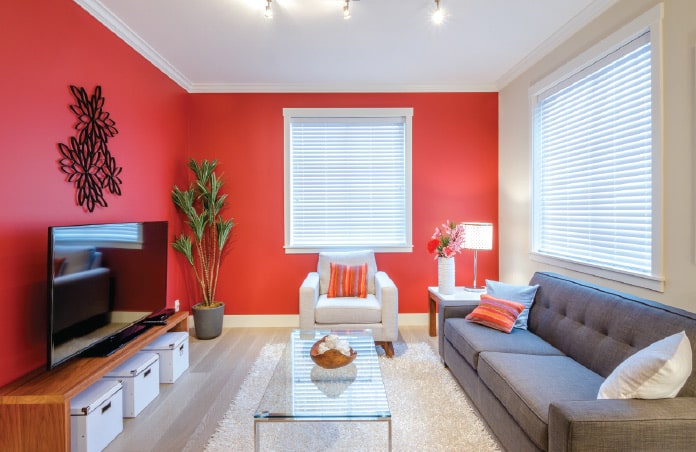Ever bought an apartment only to realize it doesn’t look quite as grand as you thought when you first stepped into the showroom model? That’s because the concept of apartment living is to sell a certain lifestyle. And with your bare apartment, you need to then re-create that “lifestyle” you imagined when you bought it. Here are some useful tips you can use to transform your new home into what you envisioned when you made your purchase.

ARRANGEMENT OF SPACES
The first thing we need to understand is that every apartment will come in its most basic form. So before you start any ID renovations, you first need to determine how you will map out your new home.
While most rooms may have already been pre-assigned, you might want to think outside the box to rearrange the space to suit your personalized needs. In this example, we look at an apartment for a bachelor who is living alone. The apartment comes with open-plan living divided into three main areas – the living, dining and TV areas. The suggested layout may well be the norm when it comes to conventional design, but our bachelor client does not watch much TV.
We thus move things around a little. We change the living area into the dining area, so there is no need to crossover the apartment to move food from the kitchen to the dining table. We also change the TV area into a study room, since our client commonly brings work home, and would use a study a lot more than a TV den.

As well as being more suited for our client’s personalized lifestyle, our new draft plan illustrates a more effective linear arrangement, where the movement between dining and kitchen run parallel to the living and study areas. In this arrangement, the spaces are planned out such that there is no crossing of paths, giving a more orderly arrangement to the room. By understanding the flow of movement, we can determine how spaces can be placed within an open plan. Even with open plan living, life is a lot smoother when you plan your area layouts properly, in advance of moving in.
DESIGN NOW – NOT LATER
The next key component is to assign the lighting and electrical circuits to suit the use of the rooms. While this item does take up a bit of our renovation budget, it is important to note that there is never enough when it comes to electrical points and lights. Accommodate what you need now and for the future, as any additions later on will result in exponential costs.
So even if you are unsure whether or not you would be using a space for a study, or a TV room, or lounge, make sure the basic electrical services are provided for, to give any user the flexibility on the usage of the room.
Also take into consideration that if you are intending to rent out the unit, you want to offer the new tenant as much flexibility as possible in how they would like to assign the rooms. The costs are minimal when compared to the grand scheme of things, and it will be these little things that sets you apart from other apartment units.
ADDING COLOURS TO WALLS
Colours are probably the most subjective topic when it comes to interior design. So a great tip to incorporate is to keep it simple and keep it clean. We never know what a wall may end up looking like, as it could be used for paintings, portraits, visuals or just a plain wall; so the best tip is to paint it in a neutral, off-white colour.
White is not just white; it comes in many different shades and tones! The subtle hues in the white can smell of blue or green or yellow, so have a look at your surroundings and match the colours accordingly. One of the great advantages of apartments is the ability to live up in the sky, so depending on which floor you are on, you can match the colours either to the sky view of blue sky and clouds, or the landscape view of trees and grass.

Avoid heavy solid colours as they tend to create a heavy feel to the room, and can contradict the design of the space later on. If you need to select a feature wall, first identify what you intend to do with the wall before selecting the colour, and not after. For example, with most art pieces, the selection of certain colours can contradict the art piece itself, while plain walls may also have a negative effect. Here the use of a beige coloured background is used to compliment the dark base of the artwork, which then accentuates the main central form of the piece. Placing this particular piece on a white-wash background on the other hand would’ve created a negative tonal effect to the art piece.
Explore the different ways you can enhance the apartment through colours and art, as these are simple techniques to create value without a major cost impact.
EXPANDING YOUR SPACE
Finally, the key to creating a home is to make sure it is designed to suit your lifestyle. Everyone has a different set of criteria by which they live, and they have different needs for how they utilize their space. Don’t let the confines of the rooms stop you from exploring your options, as most often than not, experimenting with the merging of spaces can create a whole different feel to an apartment.
In most apartments, the rooms allocated are sufficient for its specific use. Bedrooms are usually planned out large enough to house a bed and wardrobe section and nothing more. So if you find yourself in a situation where the rooms are kept vacant most parts of the year, consider merging the room with one that is fully-utilized. In doing so, you get expand your space thereby enhancing the value of the apartment. You also get more joy out of it!
But it is important to understand that in apartments, our real estate is limited to the confines of the walls, so by creating vignettes and portals that allow one space to merge with another, we are essentially doubling the effect of the space.

Take for example, a bedroom adjacent to a private study separated by a dividing wall. By removing the wall in part, we are essentially removing the idea of two individual spaces into a concept of two larger rooms. By creating a visual link, the study area feels twice as big, as it shares that link with the adjacent room and vice versa, thereby enforcing the idea of a doubling of space.
With apartments, always look at how it is laid out, and consider if the space can be enhanced to create a stunning abode. By employing the simple techniques discussed here, the result can be truly something that sets itself apart from the rest of the block!
























